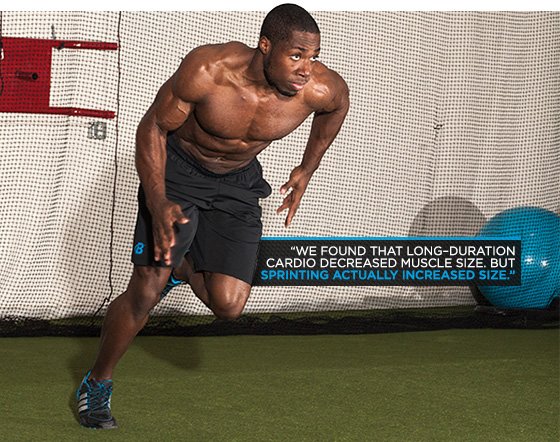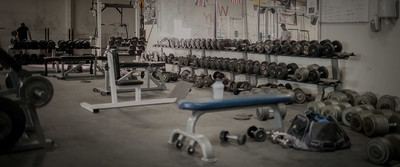Q. I hear people talking about high-intensity cardio constantly these days, but I still know a lot of guys who slog away for hours doing low-intensity work. I just want whichever one that won't cut into my gains! What should I do?
One of the undeniable hallmarks of bodybuilding is extreme muscularity. The other is razor-sharp conditioning. Look at pretty much everybody's program, and you'll see how they approach these two goals: resistance training to build mass, followed by some cardio to burn fat. Simple enough, right?
The science backs up the effectiveness of these two modalities. It's where they mix, in "concurrent training," that things get complicated. For instance, a study published in the Journal of Applied Physiology in 1998 found that 10 weeks of resistance training plus cardio resulted in greater fat loss than lifting weights alone. Unfortunately, in that same study, strength gains were cut in half when cardio was added to weightlifting.1 Other studies have similarly found that muscle growth is severely decreased when cardio is integrated into a program.2,3
There are a number of explanations as to why cardio blunts gains. One is that cardio adds extra volume to your training, making it difficult to recover from normal lifting.4 Other researchers maintain that the physiological adaptations that follow cardio training are the complete opposite of those which occur with lifting weights, and that cardiovascular gains are thus capable of cancelling out gains from weight training.5
Both of these scenarios imply that mass-seekers are paddling upstream when they begin trying to cut fat. So is it really impossible to maximize the positive effects of cardio, while eliminating the negative? My colleagues at the University of Tampa and I have been studying this question in recent years, and we have some good news for you: It is possible. It all depends on what type of cardio you choose, and how much of it you perform.
Pedal Away from the Treadmill
One of our recent studies investigated the effects that different types of cardio, their intensity, and the separation of cardio from lifting had on muscle size.6 The goal was to determine exactly which components of cardio are detrimental to resistance training results. For instance, when we compared cycling to running, we found that running caused far greater declines in muscle growth than cycling. This echoed a 2009 study in another lab which found that uphill walking produced greater decrements in strength than cycling.7
There are a couple of explanations for why this is the case. The first is that the range of motion you use when jogging or incline walking is so dissimilar from lifting weights—squatting, for instance—that it impairs strength gains in those lifts. Unlike running, however, cycling has a large range of motion at the knee and hips.
Another theory is that cycling is mainly a concentric movement and causes little muscle damage, whereas running causes a lot of muscle damage from its eccentric and elongation portions.8 This would make it easier to recover from cycling than from running.
The Importance of Intensity
Intensity and duration have an even greater effect than mode. Our study concluded that long-term fat loss is actually lowest with moderate intensity, long-duration cardio. The greatest fat loss actually occurred with the shortest duration and highest-intensity activities, like sprinting. We also saw that the longer you do cardio per day, the greater the losses are in muscle mass. However, we found very small decreases in muscle and strength when cardio was kept to less than 20 minutes per day.
"But what about the 'fat-burning zone?'" you shout from the treadmill! By this, you refer to a study conducted in the early 1990s by Dr. Romijn, who concluded that we use the most fat during exercise when performing moderate intensity (65 percent heart rate max), long-duration (45-60 minutes) cardio.9 This study's conclusions are reflected in the "fat-burning" programs on nearly every cardio machine at the gym. However, a major problem with the study is that what happens during exercise does not always reflect what will occur long term. I want to hammer this point home.

{{caption}}
My lab recently conducted another experiment where we compared low-intensity, long-duration cardio of 60 minutes with 4-10 sets of 10-30-second all-out sprints. As expected, we found that long duration cardio decreased muscle size. But get this: Sprinting actually increased size.10 This suggests that sprinting can actually be anabolic and get you shredded at the same time!
Put it All Together
OK, I know many of you are thinking right now: "If this is true, then why do so many bodybuilders have success with long-duration, low-intensity cardio? It seems to work for them…" I reply that the question is not whether long-duration cardio can help you lose fat—it can—but rather what you as an athlete need to do in order to optimize your training and reach your goals as efficiently as possible. In this case, the research is clear: High-intensity sprinting leads to greater fat loss than low-intensity, while also maintaining and possibly increasing muscle mass.
That being said, sprinting isn't easy to get started with, so it's necessary to approach it methodically. Bodybuilders seeking fat loss should try performing 10-30 second all-out sprints for between 4 and 10 reps. When I say "all-out," I mean you should feel like you are going to puke at the end of the sprint. However, I recommend beginning at the lower range and working your way up.
Once you establish your conditioning, which will likely take at least a month, you should begin to periodize your sprinting protocols. For example, if you do three sprinting sessions per week, I recommend one to be shorter duration and really high intensity, such as six 10-second hill sprints. One could be moderate duration, such as six 15-second sprints on flat ground. And finally, one should be longer, such as four 30-second all-out cycling sprints. I'm also a fan of balls-to-wall activities like car pushes and prowler or sled pushes and pulls.
Finally, try to separate your cardio from leg days by at least a day. Our lab and others have found that the effects of cardio are specific to the muscle worked. So if you do leg-intensive cardio today, it will directly affect muscle growth in your legs. What research shows clearly is that cardio ideally should be separated from legs by at least 24 hours. Otherwise you risk impairing your gains.11
That may sound like a lot of guidelines, but just think about all the time you're saving by not spending hour after hour on the treadmill. It's definitely worth a little bit of extra planning.
References
- Dolezal, B.A. and J.A. Potteiger, Concurrent resistance and endurance training influence basal metabolic rate in nondieting individuals. J Appl Physiol, 1998. 85(2): p. 695-700.
- Bell, G.J., et al., Effect of concurrent strength and endurance training on skeletal muscle properties and hormone concentrations in humans. Eur J Appl Physiol, 2000. 81(5): p. 418-27.
- Kraemer, W.J., et al., Compatibility of high-intensity strength and endurance training on hormonal and skeletal muscle adaptations. J Appl Physiol, 1995. 78(3): p. 976-89.
- Hickson, R.C., Interference of strength development by simultaneously training for strength and endurance. Eur J Appl Physiol Occup Physiol, 1980. 45(2-3): p. 255-63.
- Hakkinen, K., et al., Neuromuscular adaptations during concurrent strength and endurance training versus strength training. Eur J Appl Physiol, 2003. 89(1): p. 42-52.
- Wilson, J.M., et al., Concurrent training: a meta-analysis examining interference of aerobic and resistance exercises. Journal of strength and conditioning research / National Strength & Conditioning Association, 2012. 26(8): p. 2293-307.
- Gergley, J.C., Comparison of two lower-body modes of endurance training on lower-body strength development while concurrently training. J Strength Cond Res, 2009. 23(3): p. 979-87.
- Koller, A., et al., Effects of prolonged strenuous endurance exercise on plasma myosin heavy chain fragments and other muscular proteins. Cycling vs running. J Sports Med Phys Fitness, 1998. 38(1): p. 10-7.
- Romijn, J.A., et al., Regulation of endogenous fat and carbohydrate metabolism in relation to exercise intensity and duration. Am J Physiol, 1993. 265(3 Pt 1): p. E380-91.
- Naimo, M.A., et al., High Intensity Interval Training Has Positive Effects on Skeletal Muscle Hypertrophy, Power, and On-Ice Performance. Journal of Strength and Conditioning Research, Conference Proceedings, 2013.
- Sale, D.G., et al., Comparison of two regimens of concurrent strength and endurance training. Med Sci Sports Exerc, 1990. 22(3): p. 348-56.

